The article was updated on December 10, 2020.
Mobile shopping apps have become mainstream these days. In fact, in 2021 the volume of mobile sales is expected to reach $3.56 trillion. Retailers are no longer bound to brick-and-mortar stores, with mobile shopping offering them a viable alternative for driving revenue growth.
Interestingly enough, online shopping can get quite stressful. With so many different brands and items, sales and last-minute discounts, users might get stuck on a website or app for hours. To top it off, they will often have to switch between multiple apps when looking for an item they need.
This is exactly why personal shopper apps seem to be especially attractive to the Gen Z customers and to another age group of active smartphone users – the millennials. Young people are embracing the enhanced shopping experience created by personalized shopping assistants as they strike a delicate balance between convenience and usability.
In this article, we will take a closer look at the examples of mobile shopping assistants and uncover the best practices for building smart shopper assistant apps. Read on to learn more!
What is a mobile shopping assistant app?
Put simply, mobile shopping assistants are the apps for personal shopping. Apart from helping customers select the right products with personalized recommendations, such apps search hundreds of stores for the best deals and offers and help customers find products at the best possible price.
The services rendered by shopping assistant apps may also include
- gifts and coupons,
- booking and delivery of movie tickets, as well as
- flight booking and hotel reservations.
Capturing the best last-minute deals, bonuses and special offers can help customers save money while shopping for their favorite items from the comfort of their homes. A personal shopper app is more than just another mCommerce product. It is a smart concierge that takes the hassle out of online shopping.
Benefits of personal shopping assistant app
The benefits of a personal shopper app for a consumer are obvious. It is an automated and effortless way to shop online.
Customers using shopper assistant apps can take advantage of features like
- personalization and catering to users’ individual taste,
- automated search for brands and services to optimize spendings and save time,
- tracking and categorizing purchases,
- monitoring price fluctuations to nab the best deals, and more.
Today’s AI-based apps use self-learning algorithms to adjust their settings to customer’s individual preferences, completely discard the brands they dislike from suggestions, predict how price and demand will change with seasons, and enable users to conduct and process payments without leaving the app.
For businesses, the benefits of building personal shopper apps include high revenue potential and a vast number of monetization options. For fashion brands and retailers, building a shopping assistant app can strengthen brand loyalty and improve customer retention.

Typical features of mobile shopping assistants
The features of shopper assistant apps may differ substantially, depending on their type, as well as the technologies and algorithms applied to build a particular app. Yet, a certain set of features is an absolute must for personal shopper apps.
Below is a list of these features with brief descriptions.
- Best price comparisons. Most of the personal shopper apps include an automated price comparison. To perform an automated search for best deals, such apps compare previous customers’ choices, use data from open sources, or from partner brands.
- Gifts and coupons. No shopping assistant app can do without coupons, gifts and special deals offered to customers before they make a purchase. Personal shoppers can also showcase gifts and coupons of other brands as well as other promo content.
- Safety alerts. Shopping assistant apps also take direct responsibility for notifying users in case any particular product is unsafe or contains hazardous substances.
- Shopping history. Personal shopping apps track users’ shopping history and stores the entire list of purchases, enabling users to monitor their spendings.
- Order status. Tracking orders is another popular feature of shopping assistant apps. The user should be able to track every stage of the order delivery via a personal shopper app.
- Natural language processing. Natural language processing (NLP) is a technology for recognizing spoken or written human speech. Personal shopper apps use NLP to quickly accept requests, take orders, and answer questions imitating real-life shop assistants.
- Image recognition. An integral part of modern apps for personal shopping is digital image recognition: a programmatic feature enabling users to load images of desired products instead of a text request. The app then searches for similar items using image recognition technology.
- Personalized recommendations. This feature provides customers with unique recommendations based on their previous purchases. Similar to Netflix recommending a movie based on your previous choices, personal shopper apps generate suggestions based on the user’s purchase history: a jacket to match your sweater or a pair of shoes from your favorite brand are examples of such recommendations.
- Price predictions. This feature uses AI and big data to monitor price fluctuations. Thus, a personal shopper app can recommend customers to wait until a price on their favorite item drops, or prompt them to buy immediately to snatch the best-priced offerings.
- AI chatbot. AI chatbot automates the processing of repetitive requests and gives answers to frequently asked questions. Some apps use a combined approach: in this case, a chatbot may redirect a customer to a human assistant if a request is too complex and needs human intervention.
Best practices: building a smart shopper assistant
What makes a good shopper assistant app? The answer is simple: the assistant itself. Based on the way the users’ requests are processed, shopper assistant apps can be divided into the ones relying on actual people to handle all the tasks and the tools using artificial intelligence algorithms.
Human shopper assistants
These apps are used to connect professional shoppers, fashion advisors or brand/store agents with the users. They communicate through a simple chat interface: users make shopping requests, and the assistants further specify orders and suggest possible options that meet those requirements.
Below is an example of such app using real shopper assistants to serve the users’ needs.
Personal Shopper By Shop Your Way – The platform connects its users with personal shoppers, making it possible to buy a wide variety of goods from the group of Sears retailer companies, including Sears.com, Kmart.com, and mygofer.com.
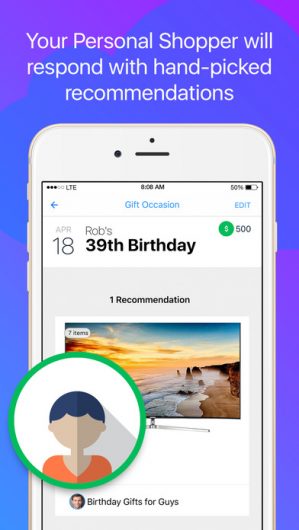
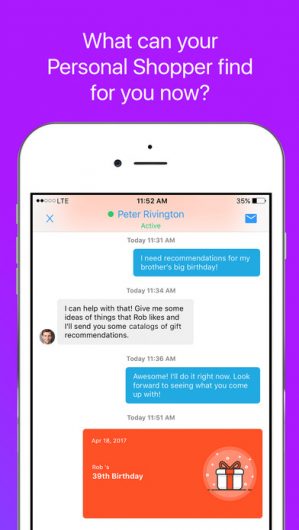
Building such an app is relatively easy. All it takes is creating chat functionality. Additionally, you will need some basic elements of a traditional mCommerce app, such as a user account, a shopping cart, payments, order tracking and shopping history.
AI-based shopper assistants
Unlike shopper assistant apps that use actual people to do all the work, AI-based applications rely on a set of machine learning algorithms. These apps provide fast and efficient shopping assistance services: it takes an algorithm significantly less time to browse through hundreds of websites and online catalogs to find the required items.
Machine learning technologies allow for advanced personalization. By sourcing data from thousands of app users, algorithms learn about their habits, individual preferences, and major shopping trends. Based on the gathered information, such tools can make tailored suggestions and improve the accuracy of search results.
The following apps rely on AI and machine learning algorithms to provide personal shopper services.
Mona – Created by a group of former Amazon employees, uses automated algorithms to browse 300+ online stores for products that meet a specific set of criteria, such as product type, style, and price. The assistant also learns about your preferences: when you use the app, and it provides personalized suggestions and promotions from the brands which you showed interest in.
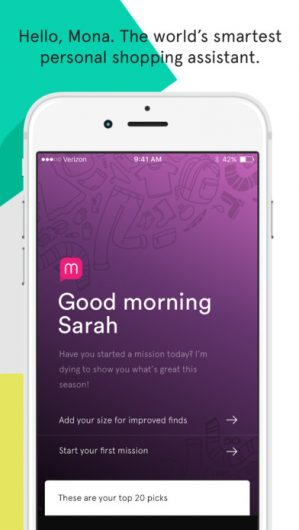
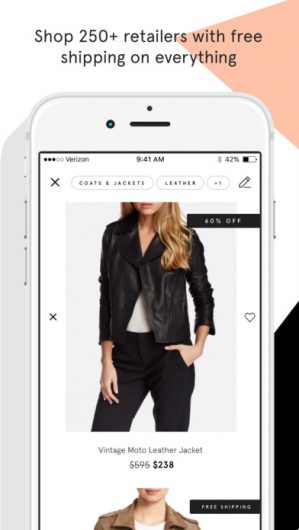
Cluise – Along with the AI-based personal shopper services, this app allows you to create a digital wardrobe by uploading photos of your clothes. The app uses image recognition technologies to process all photos, recognize your wardrobe items and sort them according to several parameters. Knowing what items you already own, it uses special algorithms to create outfits and acts as your personal stylist.
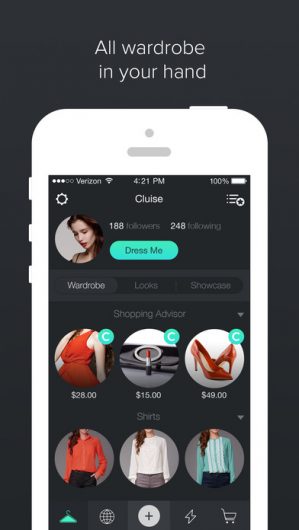

While the development of an AI-based shopper assistant app requires more effort and specific tech skills, it proves to be the most beneficial for long-term ROI. Such apps require minimum human input and tend to improve over time: self-learning algorithms become more accurate and allow for better personalization as they source more data from your users.
The increased speed and efficiency, advanced capabilities, such as visual search and price prediction, become a valuable addition that human shopper assistants cannot provide. Moreover, the level of personalization in such apps is typically higher. The algorithms are unbiased and tend to notice even the slightest details in user behavior.
Shopper assistant apps using both AI and human elements
Some apps try to capitalize on both approaches. Partially relying on human agents, such apps automate certain tasks using AI algorithms and machine learning. Combined, these approaches provide fast and efficient services, while keeping the human touch.
One of such apps is Mezi. Initially positioned as an all-purpose AI-powered virtual assistant, the startup recently pivoted to focus on travel. However, it still offers personal shopper services, providing its users with carefully selected recommendations, managing the orders and returns.
Mezi uses natural language processing to capture the most important information from users’ requests. The app then further passes it to the actual shopping experts, who chat with users and complete the tasks. The app can also learn about users’ preferences, which allows it to complete future requests faster.

While this approach might seem to use the best of both worlds, it is not really beneficial from a business point of view. This “mixed type” approach to building an app still requires heavy investment into machine learning and AI technologies. But your expenses won’t end when the app is ready: you will have to hire, train and manage your agents as well.
Chat Bot – an alternative to building a shopping assistant app
If you don’t want to build a whole new mobile app or would like to augment your existing solution, be it an application or a website, chat bots might be exactly what you are looking for.
Introduced across a number of the most popular messaging apps, such as Facebook Messenger, Slack, Skype, Viber, and Telegram, these AI-powered virtual assistants can help you with multiple tasks, including shopping.
A prominent example of such a product is the Messenger chatbot launched by mCommerce startup Spring. Following simple directions, provided by the bot, users can easily shop for any kind of clothes right within the Messenger.

How to monetize shopper assistant apps
Shopping assistant app development offers a range of monetization opportunities, making personal shopper apps a lucrative niche for investment.
Subscription-based monetization model
A very straightforward way of monetizing your personal shopping app is charging a monthly fee from app users. To fully benefit from this model and withstand the competition from free to download apps, your solution has to offer something truly unique – apart from the standard shopping assistant app features.
Freemium
You can make your app free to download but ask users to pay if they want to access some additional services. For example, the basic feature set is free, but to view their purchase history and spending analytics users will have to buy a Premium account.
Membership fees
Making your app free-to-download for customers while charging membership fees from brands and vendors that want to get featured on your platform is an excellent alternative to the subscription-based and freemium models.
Purchase commissions
Another strategy for monetizing a personal shopper app is charging commissions every time a purchase gets finalized using your app. Surely, users may not be especially excited about it, but it’s still a good way to earn money on personalized recommendation services.
Transaction fees
If your app includes a payment processing module, you may charge a small fee for processing a payment transaction. This model is widely used by companies like Uber, Etsy, and Amazon.
In-app advertising
Personal shopping assistants make great advertising platforms. A personal shopper app user base is basically a community of customers shopping for things – which is exactly what advertisers may be willing to pay for. In-app advertising models have several subtypes:
- Pay-per-click: advertisers pay each time a customer clicks on an ad;
- Pay-per-view: app owners get paid for the number of ad views;
- Pay-per-action: app owners get paid if a customer takes a specific action, like buying an advertised product.
Crowdfunding or app-sponsorship
You surely shouldn’t take crowdfunding off the table if you are building a personal shopping assistant. Your customers may be willing to pay for features they particularly enjoy, such as independent product reviews or safety notifications.
Final word
The adoption of smart personal assistants and the growth of eCommerce don’t seem to be slowing down anytime soon. Thus, more personal shopper assistants are going to flood the market, offering easy, fast, and convenient ways to shop online.
In this case, advanced use of AI and machine learning might be the only way to stand out among the competition. These technologies open up new opportunities for an even easier, faster, and more convenient, personalized approach to mobile shopping.
If you have a great app concept in mind, Eastern Peak is everything you will ever need to bring your idea to life. We have profound domain knowledge and can handle all aspects of your project development, from idea finalization to product launch and marketing.
Contact us now to get a free initial consultation.
Read also:



